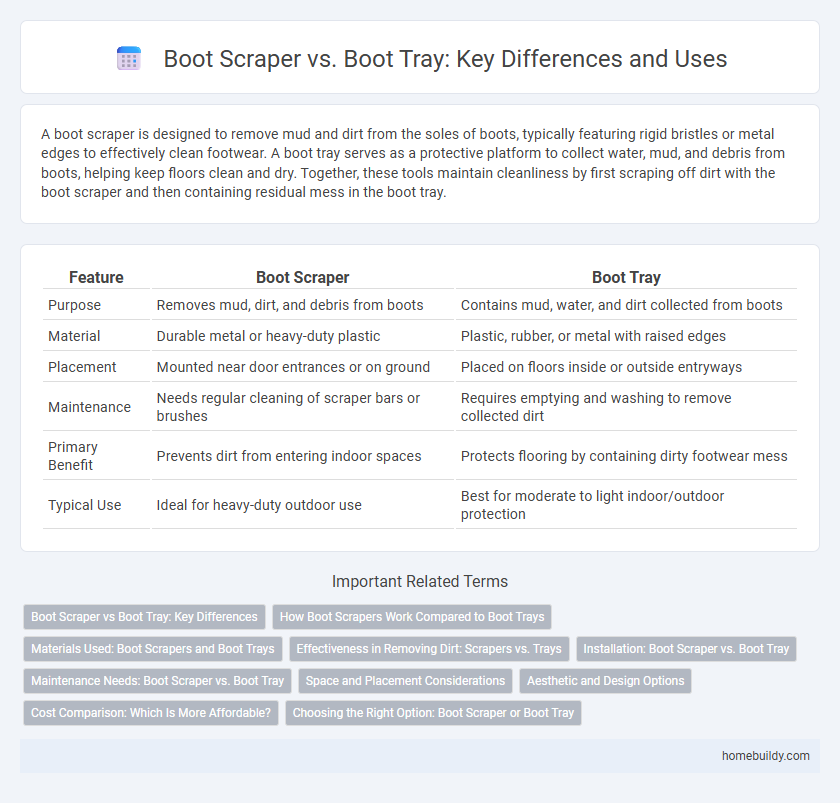A boot scraper is designed to remove mud and dirt from the soles of boots, typically featuring rigid bristles or metal edges to effectively clean footwear. A boot tray serves as a protective platform to collect water, mud, and debris from boots, helping keep floors clean and dry. Together, these tools maintain cleanliness by first scraping off dirt with the boot scraper and then containing residual mess in the boot tray.
Table of Comparison
| Feature | Boot Scraper | Boot Tray |
|---|---|---|
| Purpose | Removes mud, dirt, and debris from boots | Contains mud, water, and dirt collected from boots |
| Material | Durable metal or heavy-duty plastic | Plastic, rubber, or metal with raised edges |
| Placement | Mounted near door entrances or on ground | Placed on floors inside or outside entryways |
| Maintenance | Needs regular cleaning of scraper bars or brushes | Requires emptying and washing to remove collected dirt |
| Primary Benefit | Prevents dirt from entering indoor spaces | Protects flooring by containing dirty footwear mess |
| Typical Use | Ideal for heavy-duty outdoor use | Best for moderate to light indoor/outdoor protection |
Boot Scraper vs Boot Tray: Key Differences
Boot scrapers are designed with rigid metal or stiff bristles to effectively remove mud and debris from boots, making them ideal for outdoor use in muddy or snowy conditions. Boot trays serve as a containment solution with raised edges to hold wet or dirty footwear, preventing dirt and water from spreading indoors. The key difference lies in function: boot scrapers clean boots by removing dirt, while boot trays provide a designated area for storing cleaned or wet boots.
How Boot Scrapers Work Compared to Boot Trays
Boot scrapers use rigid metal or brush surfaces to physically remove dirt and mud from footwear, providing thorough cleaning by scraping off debris before entering a space. Boot trays, in contrast, serve as containment areas designed to hold wet or muddy boots, preventing dirt and water from spreading on floors. While boot scrapers actively clean shoes by scraping, boot trays passively collect and contain dirt and moisture.
Materials Used: Boot Scrapers and Boot Trays
Boot scrapers are typically constructed from durable metals like cast iron or stainless steel, designed to withstand outdoor conditions and effectively remove dirt and mud from footwear. Boot trays are often made from heavy-duty plastics, rubber, or metal with waterproof surfaces to contain moisture and debris indoors. The material choice for boot scrapers emphasizes rigidity and scraping effectiveness, while boot trays prioritize water resistance and ease of cleaning.
Effectiveness in Removing Dirt: Scrapers vs. Trays
Boot scrapers excel in removing stubborn, caked-on dirt and mud by providing solid edges to physically scrape debris from boots, making them highly effective for heavy-duty outdoor conditions. Boot trays primarily serve as containment solutions, preventing dirt and water from spreading inside but offering limited cleaning capability. For thorough dirt removal, boot scrapers outperform trays, while trays are better suited for managing residual moisture and keeping entryways clean.
Installation: Boot Scraper vs. Boot Tray
Boot scraper installation requires mounting the tool securely into the ground or on a fixed surface near entry points to effectively remove mud and debris from footwear. Boot trays, however, are simply placed on the floor and need little installation beyond selecting a stable, flat location near doorways. While boot scrapers demand more precise positioning and anchoring for optimal performance, boot trays offer greater flexibility and ease of setup without permanent fixtures.
Maintenance Needs: Boot Scraper vs. Boot Tray
Boot scrapers require minimal maintenance, typically involving occasional cleaning of metal blades or brushes to remove dirt and debris, ensuring effective scraping performance. Boot trays demand more frequent upkeep, as accumulated mud and water must be regularly emptied and washed to prevent mold and unpleasant odors. Choosing between the two depends on desired ease of maintenance and the volume of dirt typically encountered.
Space and Placement Considerations
Boot scrapers occupy minimal space and are typically installed outdoors near entryways to efficiently remove mud and debris from footwear. Boot trays require more indoor space for placement and serve as a designated area to contain wet or dirty boots, preventing messes on floors. Evaluating entryway size and traffic flow helps determine whether a compact boot scraper or a larger boot tray best suits spatial and functional needs.
Aesthetic and Design Options
Boot scrapers offer a rustic, functional aesthetic that complements outdoor entryways, often crafted from wrought iron or cast iron for durability and classic appeal. Boot trays provide a modern, minimalist design with sleek plastic or rubber materials available in various colors and shapes, blending seamlessly into indoor decor. Choosing between a boot scraper and a boot tray depends on desired visual impact, with scrapers enhancing traditional or vintage settings and trays suiting contemporary, clean-lined interiors.
Cost Comparison: Which Is More Affordable?
Boot scrapers generally offer a more affordable solution compared to boot trays, as they typically require less material and simpler installation. Boot trays often involve larger dimensions and more durable materials, increasing their overall cost. Choosing between the two depends on budget constraints and the level of dirt containment needed for entryways.
Choosing the Right Option: Boot Scraper or Boot Tray
Boot scrapers effectively remove mud and debris from boots outdoors, making them ideal for heavy-duty cleaning before entering a home. Boot trays serve as indoor solutions to contain moisture and dirt, protecting floors and keeping entryways tidy. Selecting between a boot scraper and boot tray depends on the primary need: outdoor dirt removal versus indoor containment and organization.
boot scraper vs boot tray Infographic

 homebuildy.com
homebuildy.com